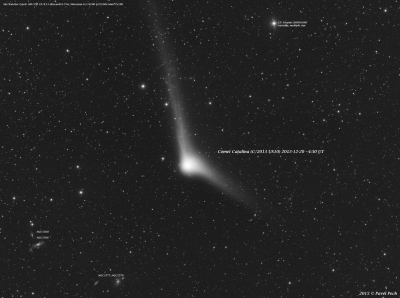I was lucky enough to get a chance to briefly beta test a new G3-16200 CCD camera from Moravian Instruments. I’ve had the camera already for couple of months before I ever got a chance to do a first light test under a real (clear) sky. The first thing I always do with a new CCD toy is to measure the readout noise. The measurement shown below was done at -25 degrees Celsius in bin 1×1 mode. Since I have zero free time to write a comprehensive article on equipment review, I will just publish few images that I was recently asked for (e.g. a dark frame – 600 seconds long, cooled down to -20).
CCD Camera Measurement:
-----------------------
Gain = 0.58
Readout Noise = 9.83e-
Total System Noise = 13.97e-
IMPORTANT! The camera was equipped with a ENG-grade class of CCD chip.
Because of the size of the chip (format 5:4, APS-H size 4540 pixels to 3640 pixels of square 6.0um = 27.24mm x 21.84mm) I assume it will be a successfull follower of the famous KAF-8300 chip.
Unfortunatelly, I have only one image out so far made with this CCD:
References
http://www.gxccd.com/art?id=461&lang=409






Hi Pavel
It’s been a very long time since we talked, it was October 2012…
You tested my G2-8300 with amazing results:
Gain = 0.38
Readout Noise = 7.25e-
Total System Noise = 8.50e-
Now I’m considering upgrading to the new G3-16200 but your test made me indecisive. I don’t know if this is really a better alternative than the G3-11000, because it uses the same Filters, so price difference is only 1k. Also the 11k looks like the better choice because of the bigger pixels and much higher full well. What do you think?
Best regards
Tobiasz
Hi Tobiasz,
the G3-11000 makes sense for LRGB imaging due to the bigger pixels (you gain in a factor of 2.25, but due to lower QE of 11000 it may end up by 1.8x). With KAI-11000 you have only hard time with proper data calibration (perfectly matching calibration frames, dithering is a must, bad pixel removal, column defect cleanup etc.), but you can still make nice images. On the other hand, for narrow band it’s from my perspective useless. G3-16200 is „just“ a lot bigger KAF-8300 that makes sense for all kind of imaging LRGB + narrow band, it is a bit cleaner than 8300 but has higher readout noise which is the only downside. But the bigger FOV is what usually matters more. The 6um pixels vs 5.4um pixels can „compensate“ the bit (1 to 1.5e-) higher readout noise. When you feel readout noise is problem (as it matters in narrow band imaging) then one „cure“ that helps is to just take longer individual subs it can to some extent compensate. So the G3-16200 is lot more universal and versatile, the smaller FOV then 11000 is „good“ for those having not high-end optical instrument that can truly illuminate such a large FOV (43mm diagonal) without significant vignetting and in reasonable star quality (small star spots). What I like on 11000 is the format of the chip (3:2) while the 16200 is 5:4 (as well as my favorite ICX694 though).
it can to some extent compensate. So the G3-16200 is lot more universal and versatile, the smaller FOV then 11000 is „good“ for those having not high-end optical instrument that can truly illuminate such a large FOV (43mm diagonal) without significant vignetting and in reasonable star quality (small star spots). What I like on 11000 is the format of the chip (3:2) while the 16200 is 5:4 (as well as my favorite ICX694 though).
Pavel